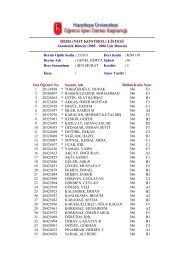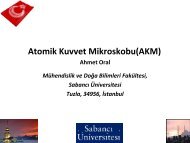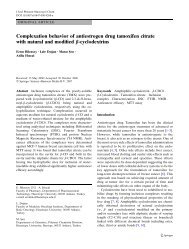2740 DUBOLAZOV ET AL.Figure 2. Convoluted emission spectrum <strong>of</strong> PAA/UO 2þ2complex in aqueous solution. k ex ¼ 310 nm,PAA/UO 2þ2¼ 2, pH ¼ 3.13. Experimental spectrum(—) obtained from UO 2þ2(---) and PAA/UO 2þ2(—)peaks.excess <strong>of</strong> UO 2þ2complex stoichiometry with nondissociatedgroups <strong>of</strong> polyelectrolyte.As <strong>the</strong> emission spectrum shown in Figure 2gives <strong>the</strong> envelope <strong>of</strong> individual peaks within <strong>the</strong>spectral range deconvolution s<strong>of</strong>tware has beenused to determine peak positions and <strong>the</strong> exactintensities <strong>of</strong> PAA/UO 2þ2spectrum. According to<strong>the</strong> changes in intensity <strong>of</strong> uranyl PAA complexband under external stimuli factors we attemptedto use <strong>the</strong> I/I 0 ratio, where I and I 0 are <strong>the</strong>luminescence intensity <strong>of</strong> PAA/UO 2þ2complexband in aqueous solution with and withoutexternally <strong>affecting</strong> factors such as, H þ or OH ,salt concentration (Na þ and K þ ), and temperature.Relative luminescence intensity <strong>of</strong> polycomplexband can serve as a qualitative evaluationcriterion <strong>of</strong> enhancement or weakening <strong>of</strong> interactionsbetween polymer and metal ions: increase<strong>of</strong> I/I 0 value can be interpreted to be asdue to a more compact structure as well as morestable. On <strong>the</strong> o<strong>the</strong>r hand, if I/I 0 value is lowerthan 1 it means that fluorescence properties <strong>of</strong>UO 2þ2species are diminished under <strong>the</strong> quenchingeffect. Contribution <strong>of</strong> both enhancement(destabilization) and quenching effect to <strong>the</strong>PAA/UO 2þ2emission spectra under external stimulieffects are separately considered later.pH EffectThe results <strong>of</strong> <strong>the</strong> previous studies showed thatchelation <strong>of</strong> metal ions by polymeric ligandsdepend on <strong>the</strong> equilibrium pH <strong>of</strong> medium. Sebastianand coworkers 24 investigated <strong>the</strong> PAA <strong>complexation</strong>with various metal ions at different pHvalues (3.45–6.0). The optimum pH for maximummetal-ion uptake by this polymer was found tobe as follows: 5.4 for Fe(III), 5.4 for Co(II), 6.2for Ni(II), 5.4 for Cr(III), and 6.4 for Zn(II). Thelimitation <strong>of</strong> pH interval was attributed to <strong>the</strong>metal hydrolysis and precipitation at higher pH.However, Bodzek et al. 25 investigated <strong>the</strong> possibility<strong>of</strong> removing Cu, Ni, and Zn ions frommodel and real galvanic wastewater at 2–10 pHregion, using PAA as flocculant. In all cases<strong>the</strong>re was an increase in <strong>the</strong> permeate flux concomitantwith increasing <strong>of</strong> pH. This phenomenonwas explained by formation <strong>of</strong> metal–PAAcomplexes more easily at higher pH.Most <strong>of</strong> <strong>the</strong> studies about <strong>complexation</strong> <strong>of</strong>UO 2þ2ions with functional group containing polymersshowed that ion exchange has been consideredas <strong>the</strong> main mechanism responsible forUO 2þ2ion separation. 26 The ion exchange mechanismfor UO 2þ2ion binding to <strong>the</strong> polymer is complicatedby <strong>the</strong> fact that <strong>the</strong> UO 2þ2ion is hydrolyzedin aqueous solutions within <strong>the</strong> pH range<strong>of</strong> <strong>the</strong> studied adsorption system and differenttype <strong>of</strong> hydrolyzed UO 2þ2ions are formed. At pH4.0, more UO 2 (OH) þ ions exist in <strong>the</strong> solution. 27Application <strong>of</strong> fluorescence spectroscopy hasbeen hampered by inconsistent interpretation <strong>of</strong>fluorescence lifetimes observed in solutions withincreasing pH. While it has been well knownthat <strong>the</strong> UO 2þ2species has a fluorescence lifetime<strong>of</strong> about 1 ls in acid solution (pH < 2), a secondlifetime contribution had been reported toappear on increasing <strong>the</strong> pH value to basic solutions.This second lifetime <strong>of</strong> about 2.5 ls hasbeen interpreted because <strong>of</strong> different fundamentalprocesses, for example, intersystem crossingor various hydrolyzed uranyl species formation.18 At pH 4, UO 2þ2is <strong>the</strong> predominant species(96%), UO 2 (OH) þ is less than 4%; at pH 5, UO 2þ2is around 69%, UO 2 (OH) þ is less than26%, (UO 2 ) 2 (OH) 2þ2is less than 5%; at pH > 5.5,<strong>the</strong> fractions <strong>of</strong> UO 2 (OH) þ (35%) and (UO 2 ) 2 (OH) 2þ2are decreased and <strong>the</strong> fraction <strong>of</strong> (UO 2 ) 2 (OH) 3þis increased with increasing pH. 28For studying <strong>the</strong> pH effect on luminescenceproperties <strong>of</strong> PAA/UO 2þ2complex we investigated1.88–4.02 pH range to avoid hydrolyzed forms <strong>of</strong>UO 2þ2. The pH dependence <strong>of</strong> <strong>the</strong> relative luminescenceintensity <strong>of</strong> <strong>the</strong> complex emission bandis shown in Figure 3a. As it can be seen from figure,I/I 0 values are lower than 1 and reachingthis value only at pH 3.25, which probablymeans that <strong>the</strong> presence <strong>of</strong> excess <strong>of</strong> H þ or OHions is unfavorable for <strong>complexation</strong> between
FACTORS AFFECTING POLYACRYLIC ACID/URANYL ION COMPLEX FORMATION 2741appearance <strong>of</strong> first uranyl hydroxide complexUO 2 (OH) þ at pH 4, which probably has less tendencyto form complexes with PAA than withUO 2þ2(aq.).Figure 3. (a) Effect <strong>of</strong> pH on <strong>the</strong> relative luminescenceintensity <strong>of</strong> PAA/UO 2þ2complex band. k ex ¼ 310nm, PAA/UO 2þ2¼ 2. (b) Effect <strong>of</strong> concentration <strong>of</strong> H þ on<strong>the</strong> relative luminescence intensity <strong>of</strong> maximumUO 2þ2band in <strong>the</strong> presence and absence <strong>of</strong> PAA. k ex ¼310 nm, [UO 2þ 2 ] ¼ 0.001 mol/L.Salt EffectFigure 4 shows <strong>the</strong> plot <strong>of</strong> relative luminescenceintensity <strong>of</strong> PAA/UO 2þ2complex band against concentration<strong>of</strong> sodium nitrate and potassium nitrate.It is seen that I/I 0 value increases withincrease in <strong>the</strong> concentration <strong>of</strong> NaNO 3 (achieving<strong>the</strong> maximum point at c ¼ 0.03 M <strong>of</strong> salt)and drastically increases in <strong>the</strong> presence <strong>of</strong>KNO 3 (maximum I/I 0 value at c salt ¼ 0.01 M). Athigher salt concentrations phase separation wasobserved, which was confirmed by turbidimetricmeasurements <strong>of</strong> PAA/UO 2þ2 /MeNO 3 mixtures,Figure 5.This experimental result suggests that <strong>the</strong>presence <strong>of</strong> inorganic salt in PAA/UO 2þ2complexaqueous solutions enhances <strong>the</strong> hydrophobicity<strong>of</strong> polycomplex particles because <strong>of</strong> an increasein luminescence intensity. 22 It should be notedthat in both cases I/I 0 values are higher than 1,indicates that luminescence intensity <strong>of</strong> <strong>the</strong> complexhas been governed by enhancement effect.It is known that ‘‘<strong>complexation</strong>’’ term is usedfor <strong>the</strong> binding <strong>of</strong> PAA with multivalent metalions (Cu 2þ , Zn 2þ , Ca 2þ , Mg 2þ , Tb 3þ , etc) and‘‘condensation’’ is conventionally used for <strong>the</strong>binding <strong>of</strong> PAA with monovalent ions (Li þ ,Na þ ,K þ , etc). In both cases electrostatic interactionUO 2þ2and PAA ligands. On <strong>the</strong> o<strong>the</strong>r hand, quenchingeffect <strong>of</strong> excess H þ cannot be ignored. Figure3b represents curves <strong>of</strong> I/I 0 values for maximumuranyl bands <strong>of</strong> uranyl spectrum in <strong>the</strong> presenceand absence <strong>of</strong> PAA versus concentration <strong>of</strong>nitric acid, which confirms <strong>the</strong> fact <strong>of</strong> quenchingeffect. 29 Therefore we propose that protons andUO 2þ2ions compete for <strong>the</strong> same binding sitesalong PAA chains. The possible mechanism <strong>of</strong>complex formation between PAA chains andUO 2þ2ions were given in our previous paper. 19As shown in Figure 3a <strong>the</strong> complex formationability increased with increase in pH, reachingmaximum values at 3.25 and <strong>the</strong>n decreased.Depression in I/I 0 value can be attributed to <strong>the</strong>Figure 4. Dependence <strong>of</strong> I/I 0 value <strong>of</strong> PAA/UO 2þ2band on <strong>the</strong> concentration <strong>of</strong> NaNO 3 (1) and KNO 3(2). k ex ¼ 310 nm, pH ¼ 3.13, PAA/UO 2þ2¼ 2.








